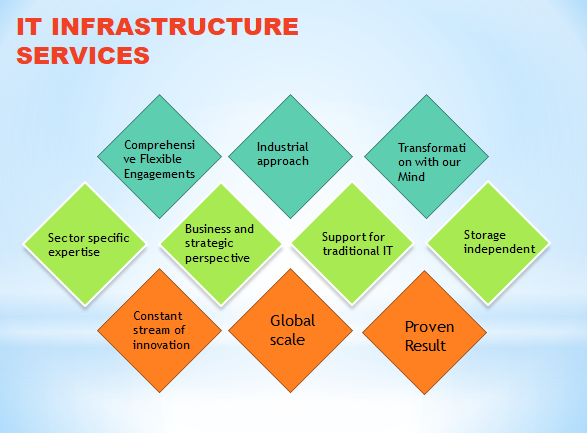Introduction of IT Infrastructure
IT Infrastructure is a set of physical resources that are supported by information technology for any administrative development. This includes hardware, software, networking, etc. to store data and various tools to ensure uninterrupted operation. The primary purpose of IT is to efficiently deliver business-critical and mission- critical services that maintain data integrity and enable decision- making and execution. In today’s digital world, a very strong and powerful foundation is essential to achieve operational excellence.
Components of IT
Hardware:
Hardware is the computer equipment in which we process server computers and many different devices through the physical conditions and in ten forms the facility of data processing data framing and the operation of various bones etc.
Software:
Software data is a collection of programs that describe the physical aspect of a computer to perform specific tasks and vice versa, along with queries to run on any type of device is necessary.
Networking:
Networking is an important technique between two connections in which we communicate with each other that can help us make decisions in the future. I can communicate with each other.
Data Storage:
Data storage is the load of the computer through which we can store any type of data and it also helps in managing various applications etc. It allows us to store business data and communicate between users. IT becomes a means to do.
Personnel:
Personal IT is where we rely on engineers, developers, and infrastructure to control various systems and use networks. Social networking includes schools networks email, etc.
Cloud and virtualization Resources:
Cloud and virtualization is the process in which technology resources are moved across different physical and the resources allocated to different physical machines in the cloud computing environment is an important form cloud and virtualization.
Types of IT Infrastructure
Traditional :
Traditional infrastructure is the basic framework in which traditional is usually hardware, software, a lot of software, networking, computers intern prize. Cause.
Cloud Infrastructure:
Cloud infrastructures are miracles that require cloud computing and include computing power, networking, storage and interface that enables users to access cells.
Hyper converged Infrastructure:
Hyper-converged infrastructure computing combines situations where at least three or more nodes can outsource all computing and storage such as up problems to meet memory requirements in seconds.
Highbrid Infrastructure:
Hybrid infrastructures consist of a collection of private cloud data centers in which a system can run application seamlessly in any of the environments that many businesses need for strategic needs and flexible performance Benefits are offered to Ricoh.
Advantage of Infrastructure
Efficiency and automation:
Efficiency and automation make many businesses stand out with the ability to reduce many of the most demanding tasks .
Scalability:
In today’s new technology integration and allowing other resources, scalability becomes more important in business development.
Cost Reduction:
Cost advocacy is the process of high profitability and cost minimization in which costs are identified that customers do not frame as much added value while achieving high performance.
Data Security:
Data security today includes many measures to make the infrastructure very robust, such as encrypted reader firewalls and regular backups.
Continuity of Business:
Recovery Social Closure in Business Continuity There are many barriers during emergencies that business continuity can be used ease. It has to be done.
Disadvantage of Infrastructure
High Initial costs:
High initial cost which demands significant initial hardware and software investment.
Maintenance:
Updates released past maintenance require personnel with more troubleshooting and optimization skills than maintenance and reflect complexity.
Downtime Risks:
Downtimes are threats such as hardware failure or patience attacks that cause network problems to become more disruptive rather than resolved leading to greater network degradation.
Security Concerns:
Due to high security concerns, the correct configuration goes wrong, causing the system to malfunction and not function properly.
Conclusion:
IT Infrastructure Components and advantage disadvantage for success organized in the digital age IT Infrastructure components types and advantage disadvantage businesses have the ability to make informed decisions to align with their core business and develop flexibility or efficiency. Make sure to make sure.
360WebSol






Leave a Reply